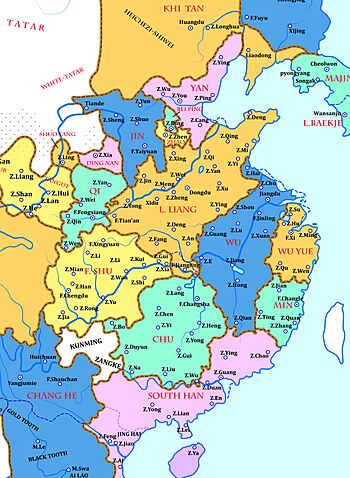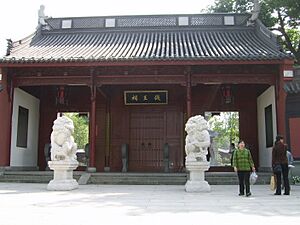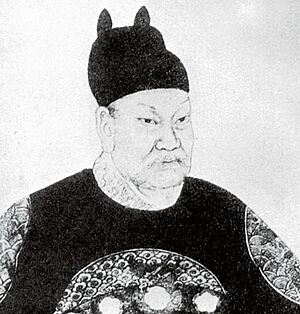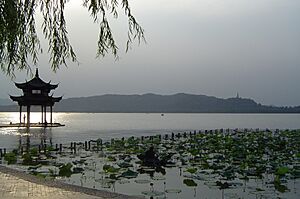Wuyue facts for kids
Quick facts for kids
Wuyue
吳越
|
|||||||||
|---|---|---|---|---|---|---|---|---|---|
| 907–978 | |||||||||

China during the early Five Dynasties and Ten Kingdoms period. A prefix of "F." indicates a city suffixed with "-fu", a prefix of "Z." indicates a city suffixed with "-zhou".
|
|||||||||
| Status | Tributary state of Later Liang, Later Tang, Later Jin, Liao, Later Han, Later Zhou, and Northern Song dynasties | ||||||||
| Capital | Qiantang (Main court; Capital) Yuezhou (Eastern court) |
||||||||
| Common languages | Wu Language | ||||||||
| Government | Monarchy | ||||||||
| King | |||||||||
|
• 907–932
|
Qian Liu | ||||||||
|
• 932–941
|
Qian Yuanguan | ||||||||
|
• 941–947
|
Qian Hongzuo | ||||||||
| Historical era | Five Dynasties and Ten Kingdoms Period | ||||||||
|
• Zhenhai Military Governorate
|
886 | ||||||||
|
• Fall of the Tang dynasty
|
907 | ||||||||
|
• Submitted to the Northern Song dynasty
|
978 | ||||||||
|
• Extinguishment
|
988 | ||||||||
| Currency | Chinese cash, Chinese coin | ||||||||
|
|||||||||
| Today part of | China | ||||||||
Wuyue (simplified Chinese: 吴越; traditional Chinese: 吳越; pinyin: Wúyuè) was a kingdom in China during a time called the Five Dynasties and Ten Kingdoms period. This period lasted from 907 to 960 AD. The Qian family ruled Wuyue. Their family name is still very common in the area where the kingdom once was.
Contents
How Wuyue Began

The Qian family started providing military leaders to the Tang dynasty in 887. Qian Liu became Prince of Yue in 902. Two years later, he also became Prince of Wu.
In 907, the Tang dynasty ended. New kingdoms formed in the south. Qian Liu used his power to declare himself the King of Wuyue. This marked the start of the Five Dynasties and Ten Kingdoms period. This period lasted until the Song dynasty began in 960.
What Does the Name Wuyue Mean?
The name Wuyue comes from two old kingdoms. These were the Wu Kingdom and the Yue Kingdom. They existed during the Spring and Autumn period (770 to 476 BC).
Where Was Wuyue Located?
The capital city of Wuyue was Hangzhou. Today, this city is also known as "Xifu". The kingdom covered areas that are now Zhejiang, Shanghai, and southern Jiangsu Province.
In 945, Wuyue also took over parts of northern Fujian. This happened when the Min Kingdom fell. The size of Wuyue was similar to the ancient Yue kingdom. However, it was not like the ancient Wu kingdom. This caused some arguments with the nearby Wu kingdom. They thought Wuyue wanted their land.
At first, Wuyue shared borders with the Min Kingdom to the south. It also bordered the Southern Tang Kingdom to the west and north. For a short time, it had a third border when Yin broke away from Min. But soon, Wuyue was surrounded by the Southern Tang kingdom. The only open side was the East China Sea.
About 550,700 families lived in Wuyue. Many people lived in busy trade centers and big seaports.
How Wuyue Was Divided
Wuyue was not as large as some other kingdoms nearby. It started with 12 main areas called prefectures. Later, it grew to 13 prefectures and 86 smaller areas called counties. Fuzhou became the 13th prefecture. This happened when the Min court joined Wuyue for protection.
Qian Liu's Rule
Under King Qian Liu, Wuyue became strong and rich. Its unique local culture also grew. He helped farming along the coast. He built walls to protect against the sea. He made Hangzhou bigger and cleaned rivers and lakes. He also encouraged trade by sea. On his deathbed, he told his sons to rule kindly. The next four kings followed his advice.
Talking with Other Countries
In 935, Wuyue officially started talking with Japan. Because it was on the coast, Wuyue also had contact with northern China, the Khitans, and the Korean states. These Korean states included Later Baekje, Balhae, Goryeo, and Silla.
Buddhism was very important in talks with Japan and Goryeo. Monks from Japan and Korea visited Wuyue. Wuyue monks also traveled to Japan and Korea. The kings of Wuyue also tried to find Buddhist texts (sutras) that were lost during the end of the Tang dynasty.
In 947, Qian Zuo sent gifts to Japan and offered to buy any sutras. But none were available. In 961, Qian Chu sent valuable items and a letter to Goryeo. He asked about the missing sutras. Gwangjong, the king of Goryeo, sent a monk named Jegwan with a full set of Tiantai sutras.
The End of the Kingdom
In 978, the last king of Wuyue, Qian Chu, gave up his power to the Song dynasty. This saved his people from war and economic ruin. Qian Chu remained king in name, but Wuyue became part of the Song dynasty. This officially ended the kingdom. The last king died in 988.
What Wuyue Left Behind
Culture and Art
The Wuyue Kingdom made the Wuyue region important in China for many centuries. It also created a special local culture. This culture is different from the rest of China. The kings of Wuyue strongly supported Buddhism. They also supported architecture, temple decoration, and religious sculptures related to Buddhism.
This unique culture still exists today. People in the Wuyue region speak a group of Chinese languages called Wu. The most famous one is Shanghainese. They also have special food and other cultural traditions. The Baochu Pagoda, built when Qian Chu was king, was one of many temples and pagodas built by the Wuyue kings.
Buildings and Waterways
The Wuyue Kingdom built canals and dikes. These helped the region become the richest farming area in China for many centuries. Because of this, many shrines to Qian Liu appeared across the region. Many of these can still be seen today.
The Kings' Good Reputation
Qian Liu was often called the "Dragon King" or "Sea Dragon King." This was because of his big water projects that "tamed" the seas. The kings of Wuyue are still seen as good rulers in history. People liked them because of their water projects, which brought wealth to the region. They were also praised for giving up their kingdom to the Song dynasty. This helped unite China and kept the region safe from war.
In the early Song dynasty, the Qian royal family was treated with great respect. They were second only to the ruling Zhao imperial family. Many shrines were built across the Wuyue region to remember the kings of Wuyue. Sometimes, people even worshipped them, believing they controlled the weather and farming. Many of these shrines, called "Shrine of the Qian King" or "Temple to the Qian King," are still there. The most visited one is near West Lake in Hangzhou.
Qian Liu reportedly had more than a hundred sons. They were born to many different wives. His children were sent to different parts of the kingdom. The Qian family is still very widespread in the region. Some branches are known as "important families" in their local areas.
Rulers of Wuyue
| Temple Names | Posthumous Names | Personal Names | Period of Reigns | Era Names and respective range of years | ||||||
|---|---|---|---|---|---|---|---|---|---|---|
| Chinese | Pinyin | Shanghainese | Chinese | Pinyin | Shanghainese | Chinese | Pinyin | Shanghainese | ||
| 太祖 | Tài Zǔ | Tha Tsu | 武肅王 | Wǔ Sù Wáng | Vu Soh Waon | 錢鏐 | Qián Liú | Zi Leu | 907–932 | Tianyou (天祐): 907 Tianbao (天寶): 908–912 |
| 世宗 | Shì Zōng | Sy Tson | 文穆王 | Wén Mù Wáng | Ven Moh Waon | 錢元瓘 (錢傳瓘) |
Qián Yuánguàn (Qián Chuánguàn) |
Zi Nyoe Cioe (Zi Zoe Cioe) |
932–941 | Changxing (長興): 932–933
|
| 成宗 | Chéng Zōng | Zen Tson | 忠獻王 | Zhōng Xiàn Wáng | Tson Shie Waon | 錢佐 (錢弘佐) |
Qián Zuǒ (Qián Hóng Zuǒ) |
Zi Tsu (Zi Ghon Tsu) |
941–947 | Tianfu (天福): 941–944
|
| Did not exist | N/A | N/A | 忠遜王 | Zhōng Xùn Wáng | Tson Sen Waon | 錢倧 (錢弘倧) |
Qián Zōng (Qián Hóng Zōng) |
Zi Tson (Zi Ghon Tson) |
947 | Tianfu (天福): 947 |
| Did not exist | N/A | N/A | 忠懿王 | Zhōng Yì Wáng | Tson I Waon | 錢俶 (錢弘俶) |
Qián Chù (Qián Hóng Chù) |
Zi Tsoh (Zi Ghon Tsoh) |
947–978 | Qianyou (乾祐): 948–950
|
Qian Chu gave up his power to the Song dynasty in 978. He continued to be a king in name, with different titles. He was King of Huaihai, then Hannan, then Hanyang, and Prince of Xu. Finally, he was Prince of Deng until he died in 988. After his death, he was also given the title King of Qin.
Family Tree of Wuyue Rulers
| Wuyue rulers family tree | |||||||||||||||||||||||||||||||||||||||||||||||||||||||||||||||||||||||||||||||||||||||||||||||||||||||||||||||||||||||||||||||||||||||||||||||||||||||||||||||||||||||||||||||||||
|---|---|---|---|---|---|---|---|---|---|---|---|---|---|---|---|---|---|---|---|---|---|---|---|---|---|---|---|---|---|---|---|---|---|---|---|---|---|---|---|---|---|---|---|---|---|---|---|---|---|---|---|---|---|---|---|---|---|---|---|---|---|---|---|---|---|---|---|---|---|---|---|---|---|---|---|---|---|---|---|---|---|---|---|---|---|---|---|---|---|---|---|---|---|---|---|---|---|---|---|---|---|---|---|---|---|---|---|---|---|---|---|---|---|---|---|---|---|---|---|---|---|---|---|---|---|---|---|---|---|---|---|---|---|---|---|---|---|---|---|---|---|---|---|---|---|---|---|---|---|---|---|---|---|---|---|---|---|---|---|---|---|---|---|---|---|---|---|---|---|---|---|---|---|---|---|---|---|---|---|
|
|||||||||||||||||||||||||||||||||||||||||||||||||||||||||||||||||||||||||||||||||||||||||||||||||||||||||||||||||||||||||||||||||||||||||||||||||||||||||||||||||||||||||||||||||||
Images for kids





